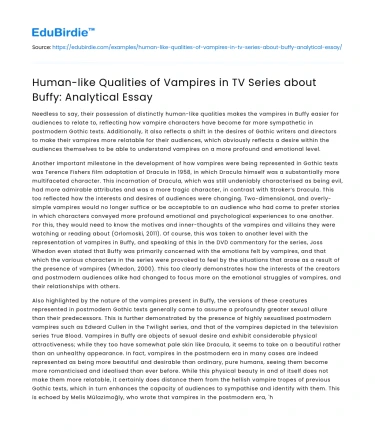Needless to say, their possession of distinctly human-like qualities makes the vampires in Buffy easier for audiences to relate to, reflecting how vampire characters have become far more sympathetic in postmodern Gothic texts. Additionally, it also reflects a shift in the desires of Gothic writers and directors to make their vampires more relatable for their audiences, which obviously reflects a desire within the audiences themselves to be able to understand vampires on a more profound and emotional level.
Another important milestone in the development of how vampires were being represented in Gothic texts was Terence Fishers film adaptation of Dracula in 1958, in which Dracula himself was a substantially more multifaceted character. This incarnation of Dracula, which was still undeniably characterised as being evil, had more admirable attributes and was a more tragic character, in contrast with Stroker’s Dracula. This too reflected how the interests and desires of audiences were changing. Two-dimensional, and overly-simple vampires would no longer suffice or be acceptable to an audience who had come to prefer stories in which characters conveyed more profound emotional and psychological experiences to one another. For this, they would need to know the motives and inner-thoughts of the vampires and villains they were watching or reading about (Orlomoski, 2011). Of course, this was taken to another level with the representation of vampires in Buffy, and speaking of this in the DVD commentary for the series, Joss Whedon even stated that Buffy was primarily concerned with the emotions felt by vampires, and that which the various characters in the series were provoked to feel by the situations that arose as a result of the presence of vampires (Whedon, 2000). This too clearly demonstrates how the interests of the creators and postmodern audiences alike had changed to focus more on the emotional struggles of vampires, and their relationships with others.
Save your time!
We can take care of your essay
- Proper editing and formatting
- Free revision, title page, and bibliography
- Flexible prices and money-back guarantee
Also highlighted by the nature of the vampires present in Buffy, the versions of these creatures represented in postmodern Gothic texts generally came to assume a profoundly greater sexual allure than their predecessors. This is further demonstrated by the presence of highly sexualised postmodern vampires such as Edward Cullen in the Twilight series, and that of the vampires depicted in the television series True Blood. Vampires in Buffy are objects of sexual desire and exhibit considerable physical attractiveness; while they too have somewhat pale skin like Dracula, it seems to take on a beautiful rather than an unhealthy appearance. In fact, vampires in the postmodern era in many cases are indeed represented as being more beautiful and desirable than ordinary, pure humans, seeing them become more romanticised and idealised than ever before. While this physical beauty in and of itself does not make them more relatable, it certainly does distance them from the hellish vampire tropes of previous Gothic texts, which in turn enhances the capacity of audiences to sympathise and identify with them. This is echoed by Melis Mülazimoğly, who wrote that vampires in the postmodern era, 'have become mainstream, civilized, tamed, vulnerable and almost human in many ways' (2014, pg. 158).
There are many other important distinctions between Victorian and postmodern vampires; the former were more intrinsically connected to nighttime and physical darkness, while the latter saw more of a departure from this archetype. For example, Dracula himself literally must sleep in his coffin during daytime out of necessity, while vampires such as Angel and Spike in Buffy are more than capable of not only operating during the daytime, but also in actual sunlight, which would have completely vaporized Dracula (Vučković, 2016), rendering them less-strictly nocturnal than their predecessors. Furthermore, while vampires in Buffy do suffer from hunger and disadvantageous side effects as a result of not feeding on blood, they, unlike Dracula, will not and cannot die from a lack of blood consumption, meaning that feeding on blood is not exactly a vital necessity for them. In fact, they can just as easily sustain their energy and health by feeding on animal blood, which in some ways makes them even easier for audiences (who are human, after all) to relate to, since it is exceptionally standard practice for actual, real-life humans to consume animals to satisfy their hunger and gain nutrition too. The vampires in Buffy are also able to eat and gain vitality from regular human food and dishes, as highlighted by Spike’s fondness of fried onion blossoms. This saw a very significant departure from the way that vampires were represented in Victorian Gothic texts, since the monstrosity and inhumanity of these vampires was very largely defined by their vital need to consume human blood. Hence, vampires in Buffy are (to some degree) able to shed/reject their monstrosity and reclaim/maintain their humanity.
The varying representations of vampires in Gothic texts over time have seen such a dramatic change in their ethics, appearances, physicality, and humanity, and seen them go from being innately evil to sympathetic (and in some cases even heroic and virtuous) characters. Hence, it can be argued that vampires in the postmodern era no longer create the same sense of fear and horror as Victorian-era vampires, since the terrifying nature of the latter stemmed predominantly from their inhuman and monstrous nature, which postmodern vampires, such as those seen in Buffy, lack, being far more relatable and human. While Stoker’s conception of Dracula was largely influenced by ancient folklore and mythology which characterised blood sucking beasts as being intrinsically demonic and unholy, the vampires in Buffy clearly exhibit some form of a moral conscience, as well as physical attributes which both render them less terrifying and make them more appealing, hence enabling audiences to draw more parallels between vampires and themselves.






 Stuck on your essay?
Stuck on your essay?

